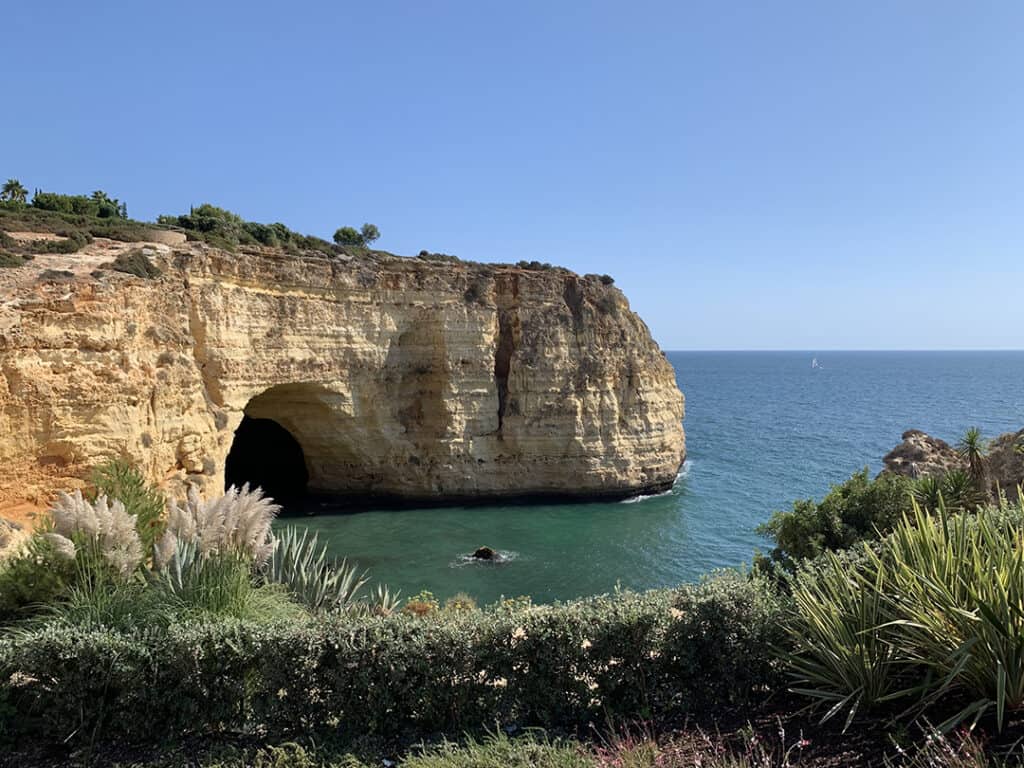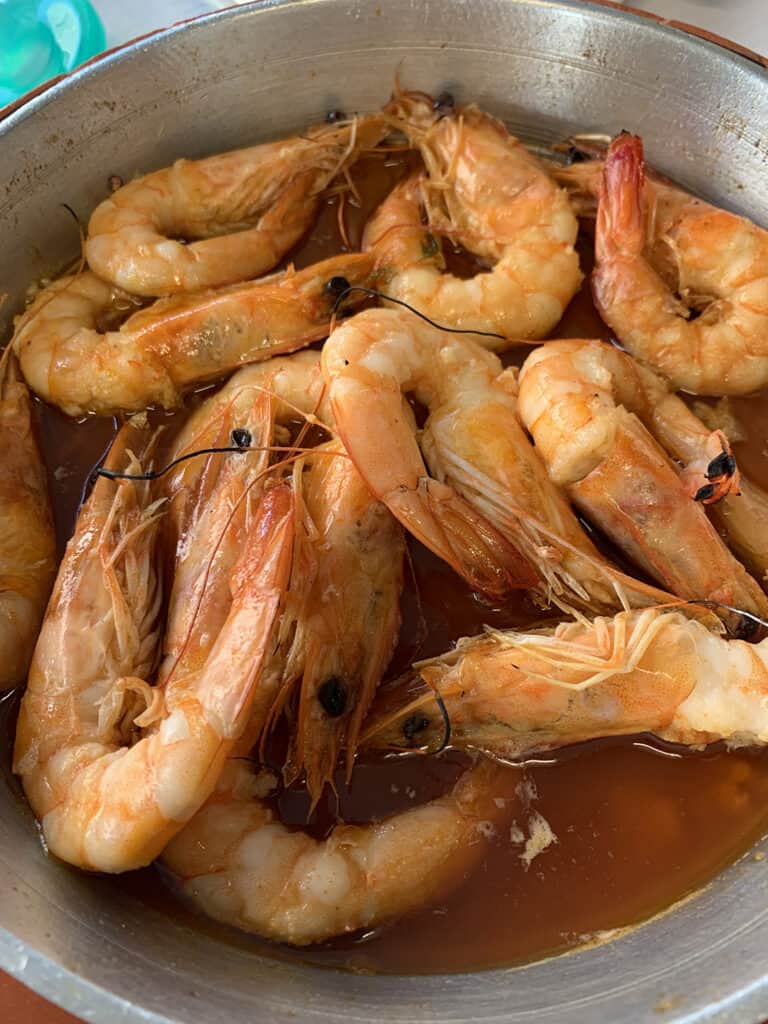An Unforgettable Trip To The Fabled Portuguese Coast.

It was the last international trip before the storm. No, I don’t mean an actual storm; I mean the proverbial storm that has upended travel since early 2020. On my last trip out of the country, I disappeared into the heart of Portugal. Ten days, two regions, one rental car, two children, one husband, and countless memorable meals.
Portugal’s Algarve Coast, a strip of southern coastline boasting Instagram-worthy photos, runs nearly 2000 square miles, from the Alentejo, in the north, to the port of Cape St. Vincent, in the south. Limestone caves and grottoes offer stunning vistas of turquoise water. In September, the weather feels nothing like fall. It’s still summer in Portugal, even when the rest of us are experiencing cool weather.
We had driven to the Algarve from Lisbon, in the north, where we spent three days stumbling around the old city, in search of the best vittles. The Algarve is less frenetic than Lisbon, more Hamptons than New York City, and it felt just about right to kick off our shoes and dig our toes into the sand and surf.
One day, in search of adventure, we headed to the petite town of Portimão. The port town, no more than a slip, is best known for its slippery, silver sardines. Walking through the Mercado Municipal — an indoor market featuring an entire room of fishmongers selling their wares — we dove into the local culture. Scales tipped with mounds of shining sardines. The reptilian claws of gooseneck barnacles — another Portuguese delicacy — reached upward. Should we take them home with us, we wondered? How should we cook them?

Each year, Portimão hosts a sardine festival, a days-long homage to the humble fish. But we had missed that proverbial boat by about a month. Instead, we walked up the narrow hill that connects town with the water until we arrived at a restaurant that seemed pleasant enough. There, my husband ordered a plate of sardines, simply grilled, while I dipped Portuguese bread into the broth accompanying a bowl of fresh clams.
We were staying not far from Portimão, in Carvoeiro, a town of just under 3,000 residents tucked between the famed beaches of Benagil and Ferragudo. Carvoeiro is known for its limestone caves, and you can see them by boat. With our children in tow, we boarded an inflatable power boat that took us from Carvoeiro’s tiny public beach out into open water, where we could see the maritime etchings of time, caves carved into arches through the lifeline of water.
In one cave, a private beach beckoned. Weary travelers took solace in the relative respite from the sun, the still-warm water, rays dipping through holes in the top, dappling the surface of the water. Elsewhere: a cave with a hole shaped like a perfect, unblemished heart.
For the most part, we ate at casual restaurants, where we could see — and eat — the sea. But one night, entirely by chance, we found ourselves at Bon, a Michelin-starred restaurant set in the idyllic hills not far from our hotel. We arrived in time to watch the mountains purple with dusk, from our table on the patio. There, a nine-course menu arrived in artful stages, each plate a piece of art in and of itself (the restaurant sources its incredible and diverse array of plates from a local ceramicist). The meal was a passionate discourse with the Algarve’s local producers.
We dined, too, at Rei das Praias, an Algarve establishment that has held court on a gorgeous, private beach since 1976. Seafood is the point here, of course, and we ordered our fish whole (the restaurant will cater to your imagination, whether you prefer your fish grilled, sautéed, or blanketed in sauce). This slice of the Algarve feels not unlike the Hamptons, with its elegant customers, accommodating beach property, and slip of sea not far out of reach.
It would be hard to overstate, too, the majesty of the region’s hotels. Ours, the Tivoli Carvoeiro Algarve Resort, overlooked a natural arch made from limestone. From the hotel’s majestic European breakfast (think rooms upon rooms of unfolding delights, from fresh produce to artisan cheeses to charcuterie), floor-to-ceiling windows reveal the panoramic landscape. The tiered saltwater pool? Just an added benefit, not unlike the rooftop bar, revealing the prismatic colors of a Portuguese sunset, night after night.
Perhaps the Algarve has worked itself into my soul so completely because it was part of my final international trip in Before Times — before Covid, before vaccination and testing wars, before masks as a de rigueur part of travel. But mostly I think that it is the charm that stays with me, those metallic sardines, glinting in the midday light; the sizzling, scarlet, heads-on langoustines served at an unnamed bistro on a Carvoeiro side street; the green-blue waters of the famed Praia de Dona Ana. It has all stayed with me: the magic, the light at dusk, the crisp white Port and tonic enjoyed as a Portuguese aperitif. The Algarve delivers. Passport and mask in hand, I’m plotting my return.










!['The Maples' is a prestigious generational compound of two extraordinary estates: 18 Maple and 22 Maple. This rare offering, designed by luxury architect Lissoni partners New York and developed by visionaries Alessandro Zampedri-CFF Real Estate and JK Living, redefines opulence with the highest quality of craftsmanship and captivating views of the Atlantic Ocean. Represented by @nycsilversurfer and @challahbackgirl of @douglaselliman. [link in bio]](https://hamptonsrealestateshowcase.com/wp-content/uploads/sb-instagram-feed-images/438891010_1083749139481747_7890082604579275354_nfull.jpg)
![Featuring 360-degree water views on Mecox Bay, the Atlantic Ocean and Channel Pond, 1025 Flying Point offers the ultimate beach cottage that is flooded with natural light. With panoramic views, proximity to the ocean, and a private walkway to Mecox bay for kayaking or paddle boarding, this truly is a special retreat. Represented by @ritcheyhowe.realestate and @hollyhodderhamptons of @sothebysrealty. [link in bio]](https://hamptonsrealestateshowcase.com/wp-content/uploads/sb-instagram-feed-images/438994305_737511778456166_4602476013493875279_nfull.jpg)
![Attention advertisers! 📣 Secure your spot in the highly anticipated Memorial Day edition #HRES. Reach thousands of potential clients and showcase your brand in one of the most sought-after publications in the Hamptons, NYC, Palm Beach, and beyond. Contact us now to reserve your ad space! [link in bio]](https://hamptonsrealestateshowcase.com/wp-content/uploads/sb-instagram-feed-images/438549843_275102939023235_6718257301437562124_nfull.jpg)
![You eat with your eyes, and on the East End, it’s important that what you eat looks just as good as how it tastes. At @rosies.amagansett, the restaurant itself is plenty photo-worthy with blue ceramic tiling and yellow and white striped fabric wallpaper. But for a dish that will light up your photos, head directly to the salmon tartare! [link in bio]](https://hamptonsrealestateshowcase.com/wp-content/uploads/sb-instagram-feed-images/437094269_7296727147115953_1594410326824303644_nfull.jpg)

![We were honored to be the media sponsor for @blackmountaincapital's open house event with @jameskpeyton and @jfrangeskos at 11 Dering Lane in East Hampton! Other sponsors included @landrover, Feline Vodka, @rustikcakestudio, @la_parmigiana, @lahaciendamexicangrill11968, @homesteadwindows, Stone Castle, @talobuilders, and @thecorcorangroup.
A big thank you Carrie Brudner of Black Mountain Capital for putting together this fabulous event! [link in bio]](https://hamptonsrealestateshowcase.com/wp-content/uploads/sb-instagram-feed-images/437081213_762912965932136_6847332836522786568_nfull.jpg)

![Blooms Galore at the Long Island Tulip Festival! 🌷✨ Mark your calendars for April 15th as the vibrant tulips at @waterdrinkerlongisland burst into full bloom! Enjoy a day filled with colorful splendor, food trucks, live music, and more. [link in bio]](https://hamptonsrealestateshowcase.com/wp-content/uploads/sb-instagram-feed-images/437083429_974242677583725_6855805712693638343_nfull.jpg)
